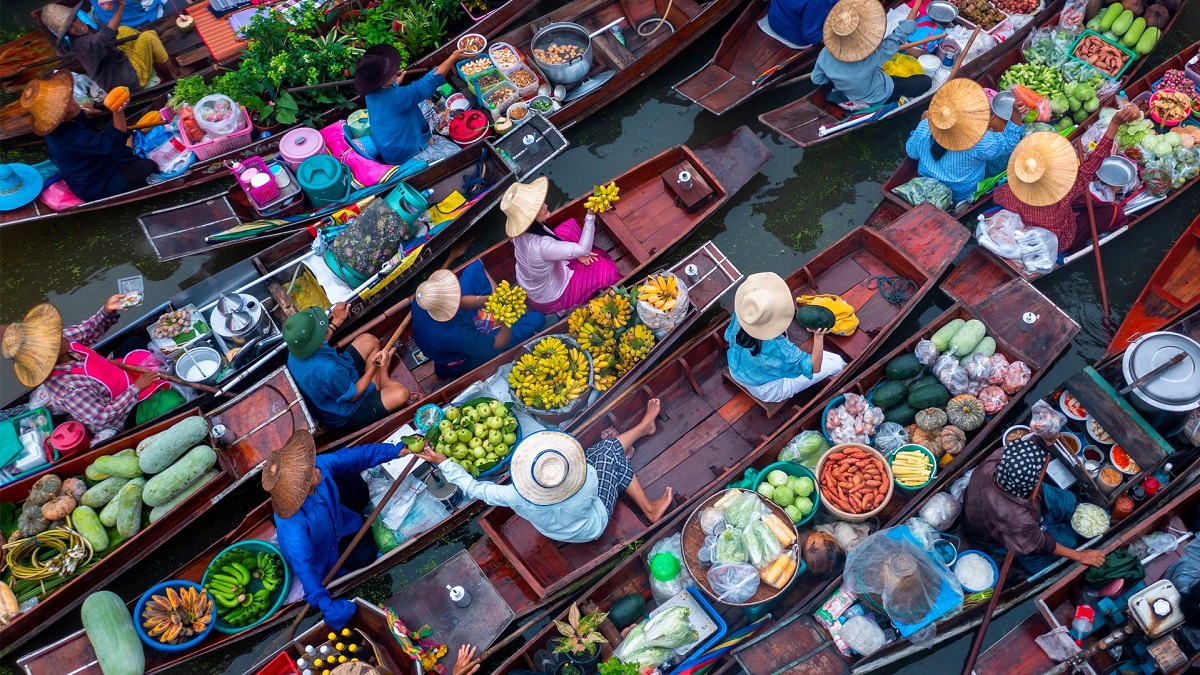New analysis fills data gaps, helping countries know how much they need to spend – and how best to allocate financial resources.
© Shutterstock/Avigator Fortuner | Farmers sell fruits and vegetables at a floating market in Damnoen Saduak, Thailand.
With the world off track to achieve the Sustainable Development Goals (SDGs), decision makers urgently need detailed cost estimates to guide their investment and spending choices.
Over the last six months, UNCTAD has crunched the numbers on nearly 50 SDG indicators across 90 countries, encompassing three quarters of the global population. The calculations cover 48 developing economies, including nine landlocked developing countries, eight small island developing states and six least developed countries.
Published on 18 September as global leaders meet in New York for the UN’s SDG Summit, the timely data underscores the pressing need for swift and targeted action.
The analysis reveals, for example, that the 48 developing economies face a $337 billion annual spending gap for indicators related to climate change, biodiversity loss and pollution.
“Merely increasing funds won’t guarantee success,” said Anu Peltola, who heads UNCTAD Statistics. “Governments, companies, investors and institutions need to strategically allocate their resources.”
The analysis reveals countries can make the most of their spending by capitalizing on synergies among the SDGs. For example, investments in education also advance gender equality, reduce poverty and stimulate innovation for progress across all SDGs.
“This has big implications for economies with limited resources,” Ms. Peltola said. “They don't have to stretch every dollar to cover every goal.”
Six transformative pathways
The analysis focuses on six transformative “pathways” for sustainable development: social protection and decent jobs, education transformation, food systems, climate change, biodiversity loss and pollution, energy transition and inclusive digitalization.
It covers indicators ranging from reducing greenhouse gas emissions and increasing protected forest cover to ensuring universal access to electricity and the internet, promoting literacy, combating hunger and reducing preventable deaths.
The study also estimates the cost of achieving gender equality for certain indicators related to ending poverty and hunger and empowering women.
Costs vary across ‘pathways’
Costs range from $5.4 trillion to $6.4 trillion annually from 2023 to 2030, depending on the pathway. This translates to between $1,179 and $1,383 per person each year.
When expanded to cover all developing economies, using the median per-capita cost for the 48 economies in the study, the total annual needs fall between $6.9 trillion and $7.6 trillion.
Gender equality and food systems command the highest costs, while the social protection and jobs pathway is the least expensive, even though it covers a wide range of targets critical for our well-being.
Roughly 80% of the total spending is anticipated to occur in the study’s upper-middle and high-income developing countries. They typically face the highest per-person annual costs and largest financing gaps. For example, their shortfall in the energy transition pathway accounts for a staggering 98% of the gap across the 48 developing economies.
Small island developing states also face high per-capita costs. Their projected spending requirements for gender equality, for example, stands at $3,724 per person – nearly triple the average.
And while the least developed countries in the study face much lower per-person costs, the required spending as a share of their GDP is daunting – surpassing 40% for all the pathways and reaching 47% for education.
Need to plug spending gaps, tackle debt crisis
The calculations reveal substantial gaps in the current spending trajectory. The largest shortfall is in inclusive digitalization, at $468 billion annually. Covering this gap would require a 9% increase in yearly spending.
Conversely, the social protection and decent jobs pathway shows the smallest gap, at $294 billion, requiring a 6% boost in annual spending.
The calculations use SDG indicators and other official statistics. The study analyses government expenditure, highlighting gaps that can be filled either from more public spending or external sources like foreign direct investments, official development assistance, remittances or external loans.
UNCTAD’s analysis also underlines the critical need to tackle the global debt crisis. About 3.3 billion people live in countries that spend more on debt interest payments than on essential public services like education and health.
Windows of opportunity
But the data underlines opportunities as well. For example, swift global action to plug the financing gap in gender equality could enable most of the 48 developing economies to meet over 60% of the gender equality indicators in the study.
“We’re not talking about an exorbitant amount of finance needed to fill the gender equality gap,” said Nour Barnat, an UNCTAD statistician.
The data shows it would cost countries roughly $78 per person annually to overcome the shortfall of current spending in the 48 developing economies. In the least developed countries, the gap to fill is less than $17 per person.
A call for more statistics
The study reiterates UNCTAD’s call to increase the availability of key official statistics on government expenditure and to improve reporting on SDG indicators in all countries.
Such improvements would allow the calculations to cover more countries. For example, because of data constraints, the study could only include nine African countries, covering 20% of the continent’s population.
The estimates aim to support efforts by countries and the global community to finance sustainable development. It’s part of a UN-wide initiative led by UNCTAD, in partnership with the UN Department of Social Affairs (UNDESA), the UN Development Programme (UNDP) and UN Women, that pools together costing tools and guidelines from a number of United Nations entities.

